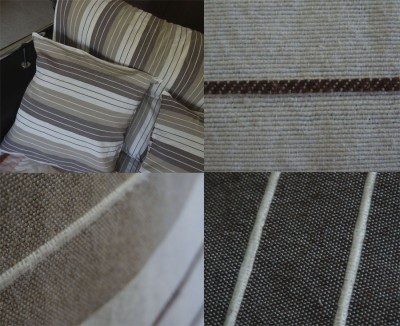Woven fabric analysis by Anna Champeney Estudio Textil
 What is the white fabric in this picture and what is it like?
What is the white fabric in this picture and what is it like?
This is traditional washable nappy fabric made from unplied cotton. It´s a double-weave fabric woven as separate layer squares.
The way that this simple, everyday fabric has been designed and woven means that fabric is soft, flexible and absorbent. Whilst few people use this fabric for nappies today it still comes in very handy for using with babies as you can see; it´s gentle on their skin.
How can you tell the fabric is double weave?
A double weave cloth is one that is woven in two completely different and complete layers. So you can tell just by looking and feeling a fabric. You can see each layer of this fabric more easily in the close-up photo. If I pull at the squares I can actually pull them open with my fingers – they´re like closed pockets.
Looking close up also makes you appreciate just how open the weave is. This makes it softer and more drapable but without reducing its absorbency. Of course it´s also cheaper for the textile mill to produce a more open fabric as less yarn is used compared to a denser fabric.
 How exactly is the fabric constructed?
How exactly is the fabric constructed?
The square design visible in the main photo is due to the separate layers of the fabric being joined together at the edge of the squares at top, bottom left and right. In double weave there are several ways to do this depending on how many shafts and pedals your loom has.
Here, warpwise, the left and right sides of each square are joined with areas of simple, one-layer plainweave which looks a more dense fabric with the threads closer together. You can see the 3 warp ends which create this effect on the closeup photo I took).
To achieve this effect means you need two extra shafts. This plainweave section will be stiffer than the double weave but it´s necessary to give the fabric consistency and to join the two layers together.
The top and bottom sides of the squares are achieved in a different way – by weaving just one pick of plainweave.
Can I weave this on 4 shafts?
Sadly, no you can´t. You need a loom with 6 shafts and at least 5 pedals to weave the double weave pockets. However, on a 4-shaft loom you CAN weave double weave tubes.
Feel inspired? Want to know more?
Contact us to arrange tuition in weave, introduction to woven fabric design and fabric analysis with Anna Champeney Estudio Textil in north Spain.

Which threads are the warp? The woven selvedge at the right and the cut edge at the top of the fabric show you that the warp runs from top to bottom in this photo.







